Types of ruffs for cleaning the chimney and the nuances of their choice

During the combustion of fuel in the stove, a lot of soot is released, which settles on the inner walls of the chimney - this leads to a decrease in draft and a decrease in the intensity of fuel combustion. As a result, gas is not removed from the heated room and can lead to household poisoning. To prevent this, they resort to regular cleaning of the chimneys.


What it is?
Boilers, fireplaces and stoves can be found in almost every private house building, cottage and summer cottage, they are installed in baths, as well as garages. Usually, coal or wood is used for the furnace, but sometimes garbage after repairs, worn out car tires and unnecessary household items are burned in the stoves. All these things in the process of burning give off a thick dark smoke in the form of solid particles, it settles inside the hood. Gradually accumulating, soot blocks the entire exhaust channel.


Other causes of chimney clogging include:
- ingress of plant particles - leaves and branches;
- complete or partial destruction of the pipe due to physical wear and tear or illiterate assembly;
- use of raw fuel - in this case, condensate is formed, interacting with the combustion products, it forms a viscous substance.


The first sign of a blockage in the chimney is the falling of soot particles onto the firebox, poor draft, sluggish combustion even with an open blower.
There are many tools available to clean your chimney. The most widespread are the brushes. Among their advantages are:
- compactness, light weight, mobility;
- the absence of any restrictions on the configuration, the height of the hood and the parameters of its section;
- the ability to adjust the weight of the load and, as a result, the applied physical effort.


The disadvantages of ruffs are the inability to break through strong and dense blockages, pull out foreign objects and eliminate condensation.
The design of any ruff includes several basic elements.
- Head - looks like a hard pile made of plastic or iron, fixed on the base.
- Weighting agent. It is made in the form of a cylinder made of lead and steel.
- Rope - serves as a base for fixing all other elements. Made of synthetic polymer fiber or steel.
- Hook - attached between the head and the load on the main cable.
- Tubing - Designed to generate maximum dynamic gain to push the brush down. Attaches to the cable.
- Replaceable nozzles - used when it is necessary to remove dense objects and break through difficult obstacles.


What are the adaptations?
Modern manufacturers offer chimney brushes in many modifications. They all differ according to the following criteria:
- shape - oval, round, square or polygonal;
- diameter - can be small (within 120-160 mm), medium (160-260 mm) and large (over 300 mm).
- sinker weight - varies from 5 to 20 kg.


Depending on the method by which the ruff is introduced into the chimney, several modifications are distinguished.
On a rope / cable - it works exclusively from above, in this case the brush moves down the pipe under the weight of the sinker. This is a rather primitive option, but it is not suitable for cleaning horizontal pipe sections.


On a flexible cable - this model resembles the one used for cleaning the sewer. The advantage is that it can be used from top to bottom as well as from bottom to top. Gives a good effect for cleaning horizontal areas.


On the rod - assumes the use of a rigid handle. The most effective option, a universal solution that allows you to quickly clean off all the soot accumulated on the surface of the chimney. Gives good results in both vertical and horizontal areas.

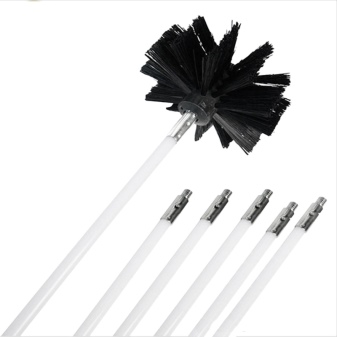
In the most modern models, the handle is telescopic, therefore, if necessary, it can be expanded or, conversely, folded.
Materials (edit)
For the production of hedgehogs, metal, plastic or nylon are used.
Metal. These brushes are the strongest, most durable and practical. Of the shortcomings, difficulties are distinguished during operation. If the bristles catch on something, it will not be easy to release them.
In addition, such products are much more expensive than plastic ones. Although, in any case, the price rarely exceeds 2 thousand rubles. Therefore, given their durability, this disadvantage is not so significant.


Plastic. Plastic brushes are very cheap, you can buy them at any store, and if necessary, quickly and easily build yourself. However, such devices wear out very quickly and fail.
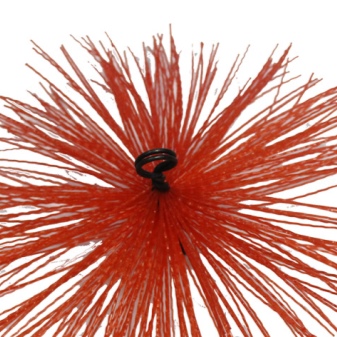

Nylon - in fact, it is the "golden mean" between plastic and metal. It has an optimal price-quality ratio.

Review of the best manufacturers
Today, the market offers products from a wide variety of manufacturers. The following brands are most popular.
Hansa Is a Lithuanian company that for many years has occupied a leading position in the segment of products for cleaning chimneys in the territory of the CIS countries and Europe. In addition to ruffs, the manufacturer offers hoses, plumbing, fittings and many other products. All of them are renowned for their high quality and durability.
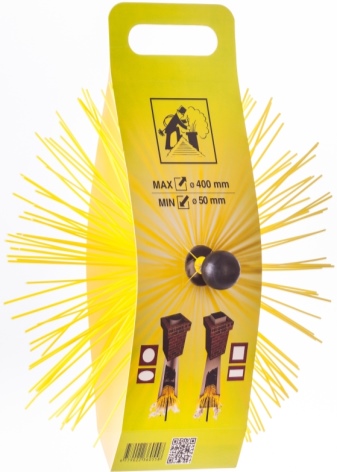

Sitecn Is an Italian manufacturer offering a wide range of chimney brushes. They have different shapes, diameters and sizes, so each user can always choose the best option for himself.


Biltema Is a Swedish company that has won recognition from European users. It manufactures universal brushes, all presented products are distinguished by a wide range, reliability and performance.

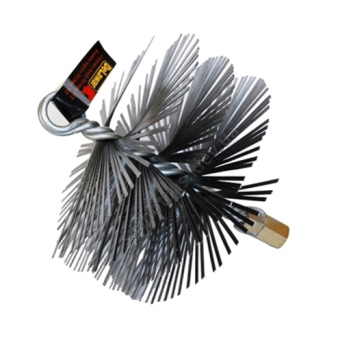
RCC Is a Polish company that produces metal and plastic brushes of medium diameter.


Of the domestic companies, the most widespread are the products of the "Chimney sweep" company.
A distinctive feature of this brand is a set with replaceable attachments included.
Secrets of choice
Let us dwell in more detail on the criteria for choosing a brush for cleaning the hood.
Cable or rigid handle. It is advisable to have both models at your disposal, so it will be much more practical to work. If there are no hatches in the pipe, then a cable will be the best solution. If the chimney is not long and there are hatches in it, models on a rigid handle will be more convenient for cleaning.
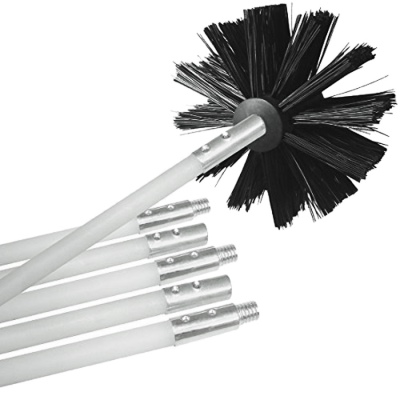
Bristle material. For chimneys made of asbestos and bricks, it is best to take a nylon or metal brush. For stainless steel pipes, only plastic is allowed, since it will not scratch the coating.
Brush diameter. This criterion is selected individually, taking into account the size of the pipe.

Length of rope or handle. Also selected taking into account the height of the chimney. In this case, they do not necessarily have to correspond to the full height, since cleaning can be carried out not only from below or from above, but also through hatches located in different parts of the hood.

How to do it yourself?
You don't have to go to the store to keep your chimneys clean. If you have some skills, you can always make a practical brush yourself at home. Of course, the effectiveness of such a product will be slightly less than that of a specialized one, therefore this solution is optimal for cleaning exhaust pipes with a low degree of contamination.

Below we will give three instructions for creating a brush:
- from a plastic bottle;
- from an ordinary broom;
- from an iron cable.

All techniques require the following.
Steel cable with a length corresponding to the height of the pipe or slightly more. Thickness 2-3.5 mm, preferably with a carabiner.
A small weight approximately 3 kg. Its size must be such that it can easily pass into the chimney. Let's say it can be a regular bottle of sand or an unnecessary dumbbell pancake.


A coil of wire with a cross section of 2-5 mm or a steel pin. In the latter version, its diameter should be 5 mm, and the length should be 10-15 cm. It is desirable that the lugs be unscrewed on both sides.
This item may present some problems. Finding a wire, bottle, weight and cable is easy - you can find them on any farm or buy at any hardware store. But picking up a hairpin is much more difficult, therefore, most often, wire is used instead.

Before starting work, it should be twisted in several layers so that in the end the thickness corresponds to 5 mm, and the length is 10-15 cm. Then it is shaped into a hairpin and used in work.
From a plastic bottle
To clean a chimney with a cross-section of up to 200 mm, a 1.5-2 liter plastic bottle is suitable. The step-by-step instruction includes several steps.
A hole is formed in the cap and on the bottom of the bottle, the diameter of which must exactly match the thickness of the pin. It can be punched, drilled or burned out.
At the bottle, slots are formed on the sides so that they do not reach the throat and bottom by 1-2 cm.The step between the individual slots should also be 1.5-2.5 cm.
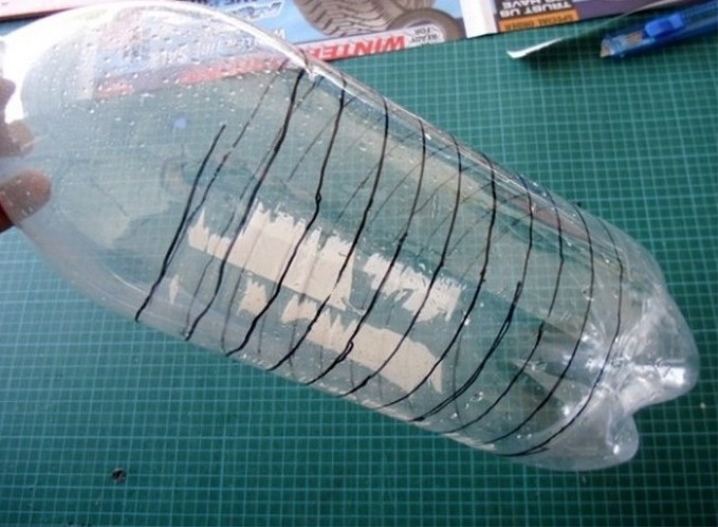
A pin is threaded into the formed holes, it should pull off both edges of the bottle. In this case, the sidewalls will bend and form a semblance of a circle of folded ribbons. It is their edges that will begin to remove soot and soot from the walls of the hood.
The eyes are twisted on the hairpin. A cable is attached to the top, a load is hooked from below.

From the broom
Making a brush at home is easy and simple from an old unnecessary broom. A round model is suitable for this, the fibers are made of polypropylene.
The procedure is as follows.
The tip of the broom is cut or removed. The bristles are straightened so that all the villi are directed in different directions, like a toilet brush.
In the block to which the bristles are attached, you should make or drill a hole with a section of 6-8 mm for the wire.
The hairpin itself is fixed into the resulting perforation. From one edge of the eyelet, a cable is fixed, from the other - a sinker.

From a metal cable
This is the most sophisticated technology that will suit people who have a welding machine at their disposal. This scheme allows you to build a highly efficient brush that is in no way inferior to store counterparts. To work you need to prepare:
- the metal cable itself;
- welding machine;
- pliers and wire cutters;
- saw for metal;
- hairpin 8-12 cm in size, certainly with thread;
- nuts for a hairpin - 5-9 pcs.


The principle of operation is as follows.
3-5 fragments are cut from the finished steel cable so that the length of each is 5-8 mm longer than the section of the hood. The trims are unweaved with pliers.
A nut is screwed onto one edge of the stud so that the thread protrudes slightly from it. It will act as a lower support for the villi of the first row. If you use bolts, then its head will be used as a support.

On top of the nut, a piece of wire from the distributed cable is attached and twisted crosswise, wrapping around the hairpin. The pieces of wire should protrude slightly.
Then the manipulations are repeated - new pieces of wire are taken and screwed again crosswise. If done correctly, the result should be an even layer of dense layer of bristle in the form of a circle.
A nut is attached on top, it firmly fixes the wire to the nut or bolt head. Several more layers of bristles are formed similarly. Usually 3-5 rows are made, each is fixed with a nut. Eyes are welded from the top and bottom. They allow you to secure the load, for which the device will go down into the chimney.

Novice craftsmen can make mistakes when creating homemade brushes. The most common are such.
The cable is too short. In this case, the ruff will simply not reach the end of the pipe, so the most difficult-to-reach area near the firebox will remain clogged.
The wire is not tight enough between the individual washers. In this situation, during the cleaning of the chimney, there is a high risk of destruction of the brush.
The width of the head is greater or less than the parameters of the channel. At the same time, it either does not reach the walls, or simply does not pass into the pipe.

How to use it correctly?
The chimney is cleaned according to the following instructions.
Before starting cleaning, it is necessary to carefully examine the chimney; for this, it is illuminated with a flashlight. A preliminary inspection will allow assessing the extent of contamination and identifying the most contaminated areas.
Next, the firebox and all chimney hatches are closed, with the exception of the hole from which cleaning will be performed.

If a spark arrester is available, it must be removed.
The brush is lowered through the pipe outlet and cleaned with up and down movements. If you find gaps, you can take a weight without bristles to punch them.
As soon as you clean the upper part of the chimney, you can go to the lower block. In this case, it is better to work through the hatch.
At the end of the cleaning, open the firebox and remove all debris that has fallen from above. Since access to the hood is only possible from a high roof, special attention should be paid to safety.

When performing work, the chimney sweep must use a belay. It will not be superfluous to put up a temporary fence. It is strictly forbidden to work on a slippery roof after rain.
It is advisable to clean before the start of the heating season, ideally annually to prevent blockages. This is the only way you can be absolutely sure that the oven will operate smoothly throughout the cold season.
Shoes must be non-slip, clothes must be closed, worn, which will not be offensive to get dirty and throw away. Even if cleaning is done as carefully as possible, soot will still get on your clothes.
Wear goggles and a respirator to keep soot out of your eyes and respiratory system. Of course, the soot that gets on the mucous membranes will not cause severe harm to a person, but it will bring noticeable discomfort.














The comment was sent successfully.